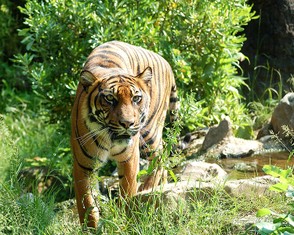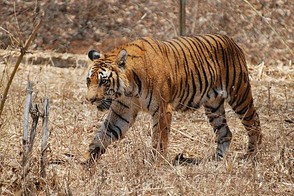Introduction
India is the only country in the world which has such a big range of different plants and animals. In India there live almost 350 mammal species, over 1200 species of birds and nearly 30000 species of insects, as well there are different species of fish, amphibians and reptiles.
Because India has this great diversity of animals and plants, it is also its task to protect all this. This is not a very easy task, because unfortunately India also is one of the main sources for wildlife trade. The demand mainly comes from other countries, but its India’s wildlife which has to suffer.
One of the most threatened species is the tiger, but India realized this rather late. In the following I will deal with India’s problem with the fade of the tiger.
First of all I will give some general information on the tiger in India. Secondly there are many projects trying to protect the tiger. Mainly non-governmental organisations fight for the survival of the tiger and also of other species. Among these are the WPSI (Wildlife Protection Society of India) and the WWF-India (World Wide Fund for Nature), which I also will introduce.
In 1972 project tiger was launched; it is a big project to safe the species of the tiger in India. Unfortunately this was too late and already three subspecies of the tiger in India had been extinct.
Tigers in China are also in danger of becoming extinct, but China has a completely different strategy. India is not really convinced of this strategy, although in China today live many more tigers than in India, but not in the wilderness.
Since project tiger has been launched, the number of tigers in India did neither really rise nor fall further; on the average it nearly stayed the same. So is it a good sign that it did not fall or does it show failure of India, because it did not increase either?
Tiger conservation is a very important topic for India. The tiger is standing at the top of the food chain and if the tiger population flourishes, the whole pyramid flourishes, otherwise the ecosystem would break down. But it is threatened by many different factors. This is a serious problem. That is why the topic of tiger conservation is an essential one and for that worth being mentioned in connection with India.
 |
 |
The Indian Tiger
General Information
The Indian tiger is the largest wild cat of the family Felidae. An adult male tiger is about 2.75-2.9 metres long and weighs about 180-260 kg; an adult female tiger is just 2.5-2.6 metres long and weighs only 100-160 kg. Usually they have a rust-brown pelt with black stripes and a white underbelly. The tiger is nearly found all over the country in many different living spaces like tropical evergreen forests, thorn forests, grass jungles, but also in deserts.
Usually tigers are living alone, except for females with cubs. Both males and females have their territories which do overlap. These territories are signed by spraying urine on plants or marking it with scratches on trees or the ground. Little tiger cubs are born all over the year but mainly in spring or late summer. Usually they are about 31-40 cm big and weigh about 800-1500 grams. They stay with their mother until they are about two years old and can find their own territories and are able to hunt. Tigers mainly hunt at night and rest during the day. On an average they kill once in eight days, just when a tigress has little cubs she kills nearly once in five days.
Threats to the tiger
Especially tigers which do not live in special reserves are threatened immensely by their surrounding, especially by humans. Among these threats are for example that their living space is getting less and less, encroachment, poaching for the illegal trade of tiger parts and many more. But also development projects like mining, hydroelectric dams and the construction of highways takes or destroys the habitat of the tiger.
From the eight subspecies that once lived in India are only five left:
-
Bengal Tiger – Panthera tigris tigris
-
Siberian (Amurian) Tiger – Panthera tigris altaica
-
Sumatran Tiger – Panthera tigris sumatrae
-
Indo-Chinese Tiger – Panthera tigris corbetti
-
South China Tiger – Pantera tigris amoyensis
Three have already been extinct:
-
Javan Tiger – Panthera tigris sondaica – extinct since early 1980’s
-
Bali Tiger – Panthera tigris balica – extinct since the 1940’s
-
Caspian Tiger – Panthera tigris virgata – extinct since the early 1970’s
In 2001-02 there lived about 3642 tigers in India, 43% of them in the tiger reserves. The result is that often many tigers live in the same place, which makes poaching much easier. Many reserves can’t protect their tigers very well, because they do not have any “established intelligence network” and nearly 80% of the reserves “do not have an armed strike force or basic infrastructure and equipment to combat poaching” (Source). So they cannot do anything against the poachers. In December 1998 three forest staff members were even murdered in Manas Tiger Reserve and there also have been some more murders since then.
Killing a tiger
Killing a tiger is actually not very expensive. Poison for one tiger costs about $ 1 or the tiger can also be killed by a steel trap which costs $ 9. Usually the poaching is done by people living in tribes in the forest, because they know the forest very well. As an example, in May 1994 a trader paid four poachers $ 15 each, for killing a tiger. But finally it is the traders and eventually some middlemen, who get the money by exploiting the tribals.
There are four different methods how wild tigers are killed:
The first one is poison which is put either in the carcasses of domestic buffaloes and cows or into small water pools especially in hot summer months.
The second method are steel traps. They are very strong and also very dangerous for humans. In one case it took six adult men to open one trap.
The third method are firearms, but they can just be used when there are as little hindrances as possible.
The last method is the electrocution. In this case a live wire is laid on animal tracts. It has between 230 volts and 11 kilovolts, because the electricity is taken from overhead electrical wires.
Organisations which protect the tiger
WPSI & WWF
WPSI
WPSI is the abbreviation for „Wildlife Protection Society of India“. It was founded in 1994 by Belinda Wright. Before she engaged in wildlife conservation she was a famous photographer and filmmaker, in the topic of wildlife. Today the WPSI is “one of the most respected and effective wildlife conservation organisations in India”.
The main intension of the WPSI is to create awareness about the problems in wildlife, like the danger of distinction of several species, because of poaching and shortage of living space. This is for example done by informing and also supporting authorities who fight against poaching and illegal wildlife trade. But they also deal with the human-animal conflict and support other conservation projects.
In order to protect wildlife, the WPSI is working on projects in many different directions. They are doing workshops for Law Enforcement Agencies, but also for institutions like the National Police Academy, the Indian Institute of Criminology, tiger reserve authorities etc.
WWF India
The WWF, what means World Wide Fund for Nature, is as its name already says active all around the world. It consists of 27 national independent organisations and its coordinating body, the WWF international, is located at Gland in Switzerland.
One part of the big network is WWF-India. WWF-India started a lot smaller as it is today. In 1969 it was founded as a “Charitable Public Trust” with the aim of saving the countries wildlife and its habitats. This was before the government and the public knew anything about the growing wildlife crisis and the protection of the environment. Also three years before the Wildlife (Protection) Act was passed.
In the beginning they did not have limited office space and hardly any full-time staff. It was based on the motivation of the founders and volunteers who put time and money into the organization. It engaged in several projects and also organized some projects that wanted to inform people about endangered animals and plants. As well they saved and tried to make money for conservation issues with the help of appeals, campaigns, by selling educational products and so on.
During the seventies and eighties they more and more specialized on the protection of wildlife and nature, with very many projects. In 1971 the Madras Snake Park was established and in 1975 the first Crocodile Bank was founded in collaboration with the Snake Park. And many more species have been protected, like the Sea Turtle and the Wolf, for example. The protection of the tiger was a very important aspect from the beginning on and also many conservationists of the WWF-India have been in the Project Tiger Steering Committee. As well the organisation was responsible for the founding of many Tiger Reserves and Wildlife Sanctuaries, and the rescuing of some sensitive wildlife areas.
Today the WWF-India is the biggest voluntary body in the line of conservation and has a big network all around the country and is present everywhere.
What it does is mainly summed up in their “mission”: “The promotion of nature conservation and environmental protection as the foundation for sustainable and equitable development.”
Today, in contrast to the beginnings of the WWF-India, it has another understanding of wildlife protection. It started with the focus on special wild plants or animals, but today the conservation involves the whole country, because everything is so closely linked and of course it also works on the human-animal conflict, to reach more harmony between humans and nature. It’s their aim that also future generations can experience “a world rich in natural resources and natural wonders.”
The real species conservation began in 1997 with the Tiger Conservation Programme. In June 2000, the conservation programme was enlarged by the conservation programmes for the Asian Elephant and Rhino. The programmes mainly deal with the threats to wildlife and everything going along with all these threats, among these threats are for example the human-animal conflict, poaching and trading of wildlife parts, habitat destruction etc. These projects are on the one hand carried out at “field level”, but on the other hand as well at “policy levels”. Mainly they are related to scientific information gathering, working with the local communities, working with local NGO’s and government agencies along with the state forest departments.
Tiger Conservation
The Tiger Conservation Programme which was launched in 1997 is governed by a Steering Committee, made up of one member from WWF-International, one from WWF-UK, one from WWF-US, one from WWF-Netherlands and three members from WWF-India. When it started, there have been seven protected areas, but the number has risen over the years to twenty-one areas today, including some tiger reserves, national parks and wildlife sanctuaries.
The two most important factors of conservation for the WWF-India is firstly that the Indian forest and grassland eco-system improves itself very fast and secondly that the tiger multiplies automatically if it is protected sufficiently and has enough food and covering possibilities. In general, those areas are taken, to be a conservation area, which are most likely to bring good results, in the improvement of habitat and the growth of as well prey species, as the tiger population.
Emergency Support for Tiger & Wildlife
But the WWF-India does not just safe the habitat of the tiger and protects it from poachers, but there are also projects like “Emergency Support for Tiger & Wildlife” and “Cattle Compensation”.
An example for when the “Tiger Emergency Support” (TEF) was needed, took place in the year 2000. Floods in River Brahmaputra set Kaziranga National Park under water, which caused a lot of panic. Three staff camps were washed away and many animals moved outside the park to safer areas, which caused a big problem for the park management because these areas lie outside the “jurisdiction of the Park”. They were afraid of serious damages and the Park staff was “already feeling the pressure on its resources”. That’s why Kaziranga was provided the TEF support “to tide over the consequences of floods”.
Another example was Panna Tiger Reserve, which was threatened by a big fire, but the emergency support has helped in preventing much damage to the Reserves ecology. One more example are the Tiger Reserves of Ranthambore & Sariska in the year 2002. They suffered from a sever drought which threatened to dry up all the water sources. It had to be reacted immediately to prevent the flight of the prey species of the tigers in search of water, and the tigers following them and for that are threatened by poachers. Here the TEF released immediately Rs. 300000 for drought relief and water management in Sariska. Later in March 2003, together with WWF-International, WWF-UK and WWF-Netherlands, WWF-India paid for four deep bore wells in Ranthambore and two in Sariska, and so reduced “the haulage and thus made it possible to fill up water sources in the Parks”.
Cattle compensation
“Cattle compensation” is especially important to counteract the human-animal conflict. By humans clearing forests to create space for housing, living space was taken from tigers and also space where their prey species lived, in other words, food resources. Without these “food resources” the tiger couldn’t find any adequate food anymore and, under these circumstances, hunted domesticated animals, like cattle. The problem is that poor farmers often lose a main source of their livelihood and in their anger kill the tiger. The government wanted to solve this problem, by paying compensation to the farmer, but it has not worked, because it takes too much time until the farmer gets the money, so it does not help him. That’s why WWF-India together with local NGO’s make these payments, about 24-48 hours after the cattle has been killed, to avoid the farmer poisoning the tiger.
This action does not really solve the problem completely, there still is no peace between humans and animals, but it is helping as well the farmer who gets compensation, as the tiger which’s life is saved.
Project Tiger
Intervention of the government
In the beginning of the 1970s, India prohibited the hunting of wild tigers by law and also counted the tigers living in the country. After this counting they realized that tigers in India are in danger of becoming extinct and started to make plans for how to save the tigers. Among the plans they developed was also one which is called “Project Tiger”. It was set going in 1972 in the Corbett National Park. The main intention behind it was to save the tigers in a way that they could multiply naturally. They wanted to realize it by creating areas where the tigers could live freely, in the environment they’re used to, but at the same time are protected, because it is prohibited to live there for example.
When the project was started there were nine such National Parks, but the number increased with the time and today exist twenty-three of these parks. All together they cover about 33000 square kilometres. The main partner of the project is the WWF (World Wide Fund for Nature), one of the biggest nature protection organisations which organizes projects around the whole world.
One cannot say that since Project Tiger has been launched there are no problems for the tiger anymore and their future is secured, the numbers are still low and tiger poaching still cannot be fully controlled. But what has changed is the awareness, especially of the government, who now puts much more effort in the conservation of tigers than ever before, because they now know how endangered the tiger is. And this does not just have effects on the tiger population, but on the whole ecosystem jungle.
In 2006 the Project Tiger was replaced by the National Tiger Conservation Authority, because the WPSI says that “India still holds the best chance for saving the tiger in the wild”.
 |
Conclusion
How well does India deal with the fade of the tiger?
It is a fact, that the threats to the tiger in India are very big and very various. Almost all these threats come from humans. It goes from poaching, over the destruction of habitat for streets, housing, mining etc. to the human-animal conflict. But it’s also humans who, at least since the 1970s, fight for the tiger and its protection.
Especially wildlife protection organisations like the WPSI or the WWF-India stand up for the conservation of the Indian wildlife and the tiger. They are doing everything they can, to protect the tiger. They raise awareness among the population and in the government, WPSI created a database with all poaching cases, they are working on the human-animal conflict, which is not an easy task, they are establishing reserves, sanctuaries and national parks etc. etc., and all of that in less than 40 years.
In reserves, sanctuaries and national parks tigers should be safe from poachers. The problem is that the government does not give enough money to these protected areas, so many of them do not have an infrastructure and the right equipment to do something against poachers. The amount of money the government spends on wildlife conservation has already risen immensely, since the start of tiger conservation, but still it is not enough. The wildlife protection organisations do still have to raise their own funds for their projects.
Of course it is bad that they did not realize the wildlife crisis before, but it is exemplary how especially protection organisations reacted.
Although the tiger population has not risen very much yet, there have been big changes. First of all the awareness of the population, but also of the government, has changed. The wildlife conservation now is an important topic one is talking about and everyone knows how important it is. Secondly tigers are saved under natural conditions, in contrast to China. This is much more work, but tigers bred in captivity do not secure the ecosystem, which, besides the conservation of the species tiger, is a main problem.
In my opinion India is dealing very well with the fade of the tiger. Of course there always could be more money from the government, better equipment for tiger reserves etc. but this all needs time. In the course of 40 years India has reached a lot not just for the tiger but for its whole wildlife. India has realized that all the animals and plants are connected in a big network and it does not help to take one part out of it and safe it, but it has to be saved in the network that the network does not break down. China did not realize that and for that now has thousands of tigers in captivity, but tigers in the wild are still in danger of becoming distinct.
Sources
 |
You might also like
White Tiger Facts for KidsWhite tigers are some of the rarest and most popular big cats in the world. R...
Siberian Tiger Facts for KidsWant to learn all sorts of fun facts about Siberian tigers, for kids to enjoy...









Comments
What beautiful creatures tigers are. My sons are fascinated by big cats. We support conservation efforts when we can in the hope that these creatures will be saved.